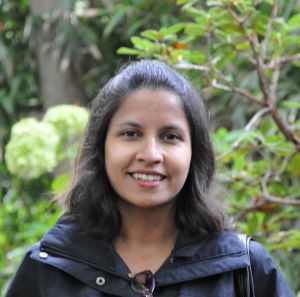
Shaama Mallikarjun Sharada
Assistant Professor
University of Southern California
The Pursuit of Free Energies and Free Energy Relationships
April 11, 4:00 - 5:00 pm
In-Person: Gowen Hall, room 201
Abstract
Chemical reactions lie at the heart of processes designed to meet our growing energy and material needs. The first step towards designing and optimizing chemical reactions involves identification of underlying mechanisms and quantification of rates. Quantum chemistry methods along with theories such as transition state theory (TST) are indispensable for this purpose and have played a pivotal role in elucidating mechanisms in recent decades. While widely successful, conventional TST is relatively simplistic and can lead to inaccurate rates for many classes of reactions. Alternative, more accurate rate theories such as variational transition state theory (VTST) that incorporate tunneling effects are well-established but incur exceptionally high computational costs which limits their widespread use. We aim to lower these costs to enhance reliability of rate predictions by adapting algorithms typically used in signal processing. I will present our algorithm that leverages matrix completion methods, widely used to recover signals from noisy, incomplete data, to recover otherwise expensive second derivatives of energy for points on the minimum energy path of a reaction. The second step is to utilize mechanistic and rate information to develop a design framework for catalysts. Hammett/Taft equations emerged as powerful tools in organic chemistry to quantify the sensitivity of reaction kinetics to substituent electronic and steric properties. Extending these principles to transition metal chemistry with molecular catalysts is a challenging task. By using density functional theory along with the activation strain model, our group is developing linear free energy relationships (LFERs) that quantify the sensitivity of reaction mechanisms to electronic and steric effects of ligands coordinated to the active center. I will demonstrate the LFER construction framework for methane activation with copper-oxygen complexes and discuss salient features and challenges associated with transferability of these design principles.
Bio
Dr. Shaama Mallikarjun Sharada is the WiSE Gabilan Assistant Professor in the Mork Family Department of Chemical Engineering and Materials Science and Assistant Professor in the Department of Chemistry at the University of Southern California. Her research interests span the development and application of quantum chemistry methods to design catalysts for sustainable chemistry transformations. Her group is developing efficient algorithms, inspired from signal processing, for advancing sophisticated rate theories in catalysis. The group is also establishing frameworks for catalyst design and discovery towards efficient natural gas conversion and light-assisted carbon dioxide utilization. Dr. Sharada received her Bachelors and Masters in Chemical Engineering from the Indian Institute of Technology, Bombay (India) where she was awarded the Institute Gold Medal. She received her PhD in Chemical Engineering from UC Berkeley in 2015 for developing efficient reaction path search algorithms for catalysis. As a postdoctoral researcher at Stanford University, her work spanned the development of machine learning density functionals and surface chemistry benchmarking databases. She is a recipient of the 2020 ACS Petroleum Research Fund Doctoral New Investigator Award and is a Scialog Fellow for the Negative Emissions Science initiative.